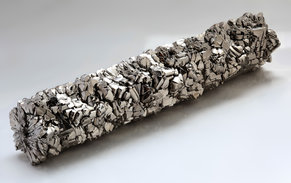Periodic Table
Of the 118 elements on the periodic table, over 90 are considered metals. The exact number of elements that are metallic depends on the definition of a metal. The following 92 elements are commonly considered metals.Actinium | Aluminum |
Americium | Barium |
Berkelium | Beryllium |
Bismuth | Bohrium |
Cadmium | Calcium |
Californium | Cerium |
Cesium | Chromium |
Cobalt | Copernicium |
Copper | Curium |
Darmstadtium | Dubnium |
Dysprosium | Einsteinium |
Erbium | Europium |
Fermium | Flerovium |
Francium | Gadolinium |
Gallium | Gold |
Hafnium | Hassium |
Holmium | Indium |
Iridium | Iron |
Lanthanum | Lawrencium |
Lead | Lithium |
Livermorium | Lutetium |
Magnesium | Manganese |
Meitnerium | Mendelevium |
Mercury | Molybdenum |
Moscovium | Neodymium |
Neptunium | Nickel |
Nihonium | Niobium |
Nobelium | Osmium |
Palladium | Platinum |
Plutonium | Polonium |
Potassium | Praseodymium |
Promethium | Protactinium |
Radium | Rhenium |
Rhodium | Roentgenium |
Rubidium | Ruthenium |
Rutherfordium | Samarium |
Scandium | Seaborgium |
Silver | Sodium |
Strontium | Tantalum |
Technetium | Terbium |
Thallium | Thorium |
Thulium | Tin |
Titanium | Tungsten |
Uranium | Vanadium |
Ytterbium | Yttrium |
Zinc | Zirconium |
Base Metals
Base metals are common and relatively inexpensive metals that are often used for industrial purposes. These metals collectively have thousands of alloys and are broadly used in products, machines, vehicles, equipment, buildings and infrastructure.Aluminium | Antimony |
Beryllium | Bismuth |
Cadmium | Chromium |
Cobalt | Copper |
Gallium | Germanium |
Hafnium | Indium |
Iron | Lead |
Manganese | Molybdenum |
Nickel | Niobium |
Rhenium | Tantalum |
Thallium | Tin |
Titanium | Tungsten |
Vanadium | Zinc |
Zirconium |
Precious Metals
Precious metals are rare metals that have economic value, often due to a traditional position within commerce and valuable industrial properties.Gold | Iridium |
Osmium | Palladium |
Platinum | Rhodium |
Ruthenium | Silver |
Rare-earth Metals
Rare-earths are a set of 17 silvery and soft heavy metals that are extremely similar to one another. Despite their name, rare-earth metals are relatively plentiful in the Earth's crust. For example, cerium is more abundant than copper. However, due to their properties these metals are widely distributed in the Earth such that exploitable deposits are rare.Cerium | Dysprosium |
Erbium | Europium |
Gadolinium | Holmium |
Lanthanum | Lutetium |
Neodymium | Praseodymium |
Promethium | Samarium |
Scandium | Terbium |
Thulium | Ytterbium |
Yttrium |

































